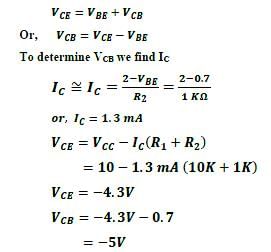Test: Basic Electronics - 1 - Electrical Engineering (EE) MCQ
25 Questions MCQ Test - Test: Basic Electronics - 1
The emitter of a transistor is doped the heaviest because of it :
Voltage power supplies use a high resistance across the output of the supply. That resistance is called
For a NPN bipolar transistor, what is the main stream of current in the base region?
Two P-N junction diodes are connected back to back to make a transistor. Which one of the following is correct?
The alpha (a) and beta (b) of a transistor are related to each other as
Application of DC voltage to a diode, transistor, or other device to produce a desired mode of operation is called
The phenomenon known as "Early Effect" in a bipolar transistor refers to a reduction of the effective base-width caused by
Which one of the following specifications is not correct for a common collector amplifier ?
The transistor configuration which provides highest output impedance is :
Consider the following statements in respect of a CC amplifier.
1. It performs a resistance transformation from low to high resistance.
2. Its current gain is close to unity
3. Its voltage gain is close to unity
4. Its frequency range is higher than that of a CE-stage.
Which of the statements is given above are correct?
when a transistor is used in switching mode then what is the turn on time ?
The voltage divider bias circuit is used in amplifiers quite often becuase it
The emitter resistor RE is bypassed by a capacitor in order to
For the BJT circuit shown, assume that the b of the transistor is very large and VBE = 0.7 V. The mode of operation
A resistor with colour bands: red-red-red-gold, has the value:
In the circuit as shown b = 99, VBE = 0.6 V, the what are the values of VC and IC corresponding to the operating point?
A silicon transistor with VBE sat = 0.8 V, b dc = 100 and VCE sat = 0.2 V is used in the circuit shown in given figure What is the minimum value of RC for which transistor is in saturation ?
The action of a JFET in its equivalent circuit can best be represented as a
Consider the following statements: FETs when compared to BJTs have
1. high input impedance.
2. current flow due to majority carriers.
3. low input impedance
4. current flow due to minority carries.
Which of the statement given above are correct ?




















